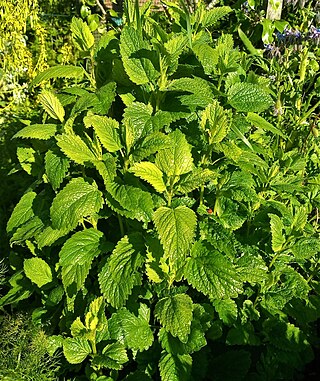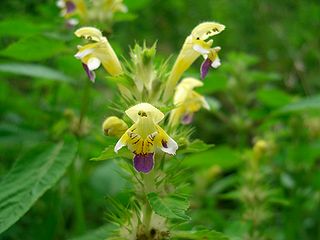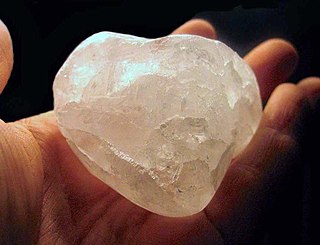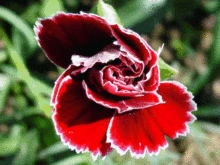
Lemon balm is a perennial herbaceous plant in the mint family and native to south-central Europe, the Mediterranean Basin, Iran, and Central Asia, but now naturalised elsewhere.

The order Lamiales are an order in the asterid group of dicotyledonous flowering plants. It includes about 23,810 species, 1,059 genera, and is divided into about 25 families. These families include Acanthaceae, Bignoniaceae, Byblidaceae, Calceolariaceae, Carlemanniaceae, Gesneriaceae, Lamiaceae, Lentibulariaceae, Linderniaceae, Martyniaceae, Mazaceae, Oleaceae, Orobanchaceae, Paulowniaceae, Pedaliaceae, Peltantheraceae, Phrymaceae, Plantaginaceae, Plocospermataceae, Schlegeliaceae, Scrophulariaceae, Stilbaceae, Tetrachondraceae, Thomandersiaceae, Verbenaceae.

Plastic surgery is a surgical specialty involving the restoration, reconstruction, or alteration of the human body. It can be divided into two main categories: reconstructive surgery and cosmetic surgery. Reconstructive surgery covers a wide range of specialties, including craniofacial surgery, hand surgery, microsurgery, and the treatment of burns. This category of surgery focuses on restoring a body part or improving its function. In contrast, cosmetic surgery focuses solely on improving the physical appearance of the body. A comprehensive definition of plastic surgery has never been established, because it has no distinct anatomical object and thus overlaps with practically all other surgical specialties. An essential feature of plastic surgery is that it involves the treatment of conditions that require or may require tissue relocation skills.

The Pure Food and Drug Act of 1906, also known as the Wiley Act and Dr. Wiley's Law, was the first of a series of significant consumer protection laws enacted by the United States Congress, and led to the creation of the Food and Drug Administration (FDA). Its main purpose was to ban foreign and interstate traffic in adulterated or mislabeled food and drug products, and it directed the US Bureau of Chemistry to inspect products and refer offenders to prosecutors. It required that active ingredients be placed on the label of a drug's packaging and that drugs could not fall below purity levels established by the United States Pharmacopeia or the National Formulary.

Atropine is a tropane alkaloid and anticholinergic medication used to treat certain types of nerve agent and pesticide poisonings as well as some types of slow heart rate, and to decrease saliva production during surgery. It is typically given intravenously or by injection into a muscle. Eye drops are also available which are used to treat uveitis and early amblyopia. The intravenous solution usually begins working within a minute and lasts half an hour to an hour. Large doses may be required to treat some poisonings.

Atropa belladonna, commonly known as belladonna or deadly nightshade, is a toxic perennial herbaceous plant in the nightshade family Solanaceae, which also includes tomatoes, potatoes and aubergine (eggplant). It is native to Europe and Western Asia, including Turkey. Its distribution extends from Ireland in the west to western Ukraine and the Iranian province of Gilan in the east. It is also naturalised or introduced in some parts of Canada, North Africa and the United States.

The doctrine of signatures, dating from the time of Dioscorides and Galen, states that herbs resembling various parts of the body can be used by herbalists to treat ailments of those body parts. A theological justification, as stated by botanists such as William Coles, was that God would have wanted to show men what plants would be useful for.

The United States Federal Food, Drug, and Cosmetic Act is a set of laws passed by the United States Congress in 1938 giving authority to the U.S. Food and Drug Administration (FDA) to oversee the safety of food, drugs, medical devices, and cosmetics. The FDA's principal representative with members of congress during its drafting was Charles W. Crawford. A principal author of this law was Royal S. Copeland, a three-term U.S. senator from New York. In 1968, the Electronic Product Radiation Control provisions were added to the FD&C. Also in that year the FDA formed the Drug Efficacy Study Implementation (DESI) to incorporate into FD&C regulations the recommendations from a National Academy of Sciences investigation of effectiveness of previously marketed drugs. The act has been amended many times, most recently to add requirements about bioterrorism preparations.

Capsella bursa-pastoris, known as shepherd's purse because of its triangular flat fruits, which are purse-like, is a small annual and ruderal flowering plant in the mustard family (Brassicaceae). It is native to eastern Europe and Asia minor, but is naturalized and considered a common weed in many parts of the world, especially in colder climates, including the British Isles, where it is regarded as an archaeophyte, North America and China, but also in the Mediterranean and North Africa. C. bursa-pastoris is the second-most prolific wild plant in the world, and is common on cultivated ground and waysides and meadows.

An astringent is a chemical that shrinks or constricts body tissues. The word derives from the Latin adstringere, which means "to bind fast". Astringency, the dry, puckering or numbing mouthfeel caused by the tannins in unripe fruits, lets the fruit mature by deterring eating. Tannins, being a kind of polyphenol, bind salivary proteins and make them precipitate and aggregate, producing a rough, "sandpapery", or dry sensation in the mouth.
Natural skin care uses topical creams and lotions made of ingredients available in nature. Much of the recent literature reviews plant-derived ingredients, which may include herbs, roots, flowers and essential oils, but natural substances in skin care products include animal-derived products such as beeswax, and minerals. These substances may be combined with various carrier agents, preservatives, surfactants, humectants and emulsifiers.
Monoterpenes are a class of terpenes that consist of two isoprene units and have the molecular formula C10H16. Monoterpenes may be linear (acyclic) or contain rings (monocyclic and bicyclic). Modified terpenes, such as those containing oxygen functionality or missing a methyl group, are called monoterpenoids. Monoterpenes and monoterpenoids are diverse. They have relevance to the pharmaceutical, cosmetic, agricultural, and food industries.

Andrographis paniculata, commonly known as creat or green chiretta, is an annual herbaceous plant in the family Acanthaceae, native to India and Sri Lanka.

Cosmetic testing on animals is a type of animal testing used to test the safety and hypoallergenic properties of cosmetic products for use by humans.

Nepeta cataria, commonly known as catnip, catswort, catwort, and catmint, is a species of the genus Nepeta in the family Lamiaceae, native to southern and eastern Europe, the Middle East, Central Asia, parts of Mongolia, and parts of China. It is widely naturalized in northern Europe, New Zealand, and North America. The common name catmint can also refer to the genus as a whole.

Herbs are a widely distributed and widespread group of plants, excluding vegetables and other plants consumed for macronutrients, with savory or aromatic properties that are used for flavoring and garnishing food, for medicinal purposes, or for fragrances. Culinary use typically distinguishes herbs from spices. Herbs generally refers to the leafy green or flowering parts of a plant, while spices are usually dried and produced from other parts of the plant, including seeds, bark, roots and fruits.

Aromatherapy is a practice based on the use of aromatic materials, including essential oils and other aroma compounds, with claims for improving psychological well-being. It is used as a complementary therapy or as a form of alternative medicine, and typically is used via inhalation and not by ingestion.

Mastic is a resin obtained from the mastic tree. It is also known as tears of Chios, being traditionally produced on the island Chios, and, like other natural resins, is produced in "tears" or droplets.

Hemp juice is a beverage derived from industrial hemp, made from the result of pressing the Cannabis sativa plant. The juice is obtained through a large-scale industrial cold-pressing procedure using the upper parts of the hemp plant as well as the leaves. This procedure distinguishes hemp juice from other hemp products such as hemp oil, hemp sprouts or hemp milk, which are obtained through the seeds of the hemp plant.

The term cosmetic packaging is used for containers and secondary packaging of fragrances and cosmetic products. Cosmetic products are substances intended for human cleansing, beautifying and promoting an enhanced appearance without altering the body's structure or functions.

















